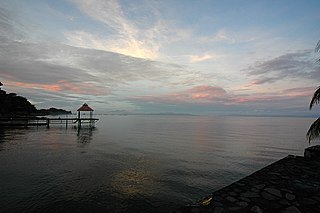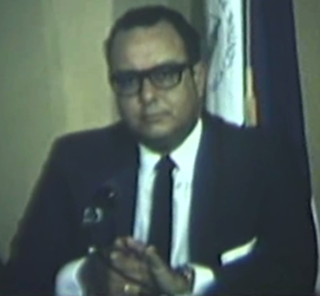
Lake Nicaragua or Cocibolca or Granada is a freshwater lake in Nicaragua. Of tectonic origin and with an area of 8,264 km2 (3,191 sq mi), it is the largest fresh water lake in Central America, the 19th largest lake in the world and the tenth largest in the Americas, slightly smaller than Lake Titicaca. With an elevation of 32.7 metres (107 ft) above sea level, the lake reaches a depth of 26 metres (85 ft). The intermittent Tipitapa River feeds Lake Nicaragua when Lake Managua has high water. Lake Cocibolca is between two other bodies of water, on top is Lake Xolotlán and below is the San Juan River. These body of waters complete the largest International Drainage Basin in Central America.

Nicaragua, officially the Republic of Nicaragua, is the geographically largest country in Central America, comprising 130,370 km2 (50,340 sq mi). With a population of 7,142,529 as of 2024, it is the third-most populous country in Central America after Guatemala and Honduras.
Nicaragua is a nation in Central America. It is located about midway between Mexico and Colombia, bordered by Honduras to the north and Costa Rica to the south. Nicaragua ranges from the Caribbean Sea on the nation's east coast, and the Pacific Ocean bordering the west. Nicaragua also possesses a series of islands and cays located in the Caribbean Sea.

The Sandinista National Liberation Front is a Christian socialist political party in Nicaragua. Its members are called Sandinistas in both English and Spanish. The party is named after Augusto César Sandino, who led the Nicaraguan resistance against the United States occupation of Nicaragua in the 1930s.

Managua is the capital and largest city of Nicaragua, and one of the largest cities in Central America. Located on the shores of Lake Managua, the city had an estimated population of 1,055,247 as of 2020, and a population of 1,401,687 in its metropolitan area. The city also serves as the seat of Managua Department.

Anastasio "Tachito" Somoza Debayle was the 53rd President of Nicaragua from 1967 to 1972 and again from 1974 to 1979. As head of the National Guard, he was de facto ruler of the country between 1967 and 1979, even during the period when he was not the de jure ruler.

Granada is a city in western Nicaragua and the capital of the Granada Department. With an estimated population of 105,862 (2022), it is Nicaragua's ninth most populous city. Granada is historically one of Nicaragua's most important cities, economically and politically. It has a rich colonial heritage, seen in its architecture and structure.
Edén Atanacio Pastora Gómez was a Nicaraguan politician and guerrilla who ran for president as the candidate of the Alternative for Change (AC) party in the 2006 general elections. In the years prior to the fall of the Somoza regime, Pastora was the leader of the Southern Front, the largest militia in southern Nicaragua, second only to the FSLN in the north. Pastora was nicknamed Comandante Cero.

The Nicaraguan Revolution began with rising opposition to the Somoza dictatorship in the 1960s and 1970s, the ouster of the dictatorship in 1978–79, and fighting between the government and the Contras from 1981 to 1990. The revolution revealed the country as one of the major proxy war battlegrounds of the Cold War.

Ernesto Cardenal Martínez was a Nicaraguan Catholic priest, poet, and politician. He was a liberation theologian and the founder of the primitivist art community in the Solentiname Islands, where he lived for more than ten years (1965–1977). A former member of the Nicaraguan Sandinistas, he was Nicaragua's minister of culture from 1979 to 1987. He was prohibited from administering the sacraments in 1984 by Pope John Paul II, but rehabilitated by Pope Francis in 2019.

Ometepe is an island formed by two volcanoes rising out of Lake Nicaragua, located in the Rivas Department of the Republic of Nicaragua. Its name derives from the Nahuatl words ome (two) and tepetl (mountain), meaning "two mountains". It is the largest island in Lake Nicaragua.
The NicaraguanNational Guard was a militia and a gendarmerie created in 1925 during the occupation of Nicaragua by the United States. It became notorious for human rights abuses and corruption under the regime of the Somoza family (1936–1979). The National Guard was disbanded when the Sandinistas came to power in 1979.
The history of the Jews in Latin America began with conversos who joined the Spanish and Portuguese expeditions to the continents. The Alhambra Decree of 1492 led to the mass conversion of Spain's Jews to Catholicism and the expulsion of those who refused to do so. However, the vast majority of conversos never made it to the New World and remained in Spain slowly assimilating to the dominant Catholic culture. This was due to the requirement by Spain's Blood Statutes to provide written documentation of Old Christian lineage to travel to the New World. However, the first Jews came with the first expedition of Christopher Columbus, including Rodrigo de Triana and Luis De Torres.

The Solentiname Islands are an archipelago towards the southern end of Lake Nicaragua in the Nicaraguan department of Río San Juan.

Matagalpa is a city in Nicaragua which is the capital of the department of Matagalpa. The city has a population of 112,697, while the population of the department is 606,643. Matagalpa is Nicaragua's seventh largest city, the largest in the country's interior, and one of the most commercially active outside of Managua. Matagalpa is known as the "Pearl of the North" and "Land of Eternal Spring."

The Sandinista Popular Army (SPA) was the military forces established in 1979 by the new Sandinista government of Nicaragua to replace the Nicaraguan National Guard, following the overthrow of Anastasio Somoza Debayle.

Tourism in Nicaragua has grown considerably recently, and it is now the second largest industry in the nation. Nicaraguan President Daniel Ortega has stated his intention to use tourism to combat poverty throughout the country.

A Nicaraguan American is an American of Nicaraguan descent. They are also referred to as "nica" or "nicoya".
The history of the Jews in Nicaragua dates back to the 1400s. Jewish Nicaraguans or Nicaraguan Jews are Nicaraguans of Jewish ancestry who were born in or have immigrated to Nicaragua. They are part of the ethnic Jewish diaspora.

Zapatera is an archaeological site located on Isla Zapatera, a volcanic island in Lake Nicaragua, Granada Department, Nicaragua. The large quantity of statues, petroglyphs and pottery found at the site, and on other islands in the Zapatera archipelago, suggests the area was an important ceremonial centre of pre-Columbian Chorotega people between 800 and 1350 CE.












